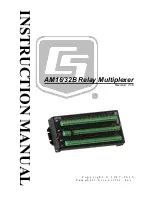
Changing the Fuse in the MY64 Multimeter
15 September 2005, by Bob Lineberry, Page 1
When the user exceeds the current capacity of the MY64 multimeter, an internal fuse opens to protect
the precision current shunt. Typically this occurs when the user leaves the multimeter in current
measuring mode and places the probes across a voltage source.
Page 26 of the MY64 Operator’s Manual instructs the user to:
•
Disconnect the test leads
•
Remove the screws on the back cover and open the case
•
Take the PCB out from the front cover
•
Replace the blown fuse with the same ratings
The above explanation leaves out a few details, which may frustrate a user. Here are some instructions
with pictures to help you be successful.
WARNING! Static discharge can destroy your meter. The ECE department will not be responsible for
meter abuse. If you have any doubts about your ability to perform this procedure, consult with a
Teaching Assistant in the Computer Engineering Labs.
After removing the test leads, separate the meter from the yellow bumper, using your fingers to peel
from the top.
Turn the meter on its face on a soft surface. Unscrew the 3 identical screws with a #2 Phillips
screwdriver. The screws have a right-hand thread, so turn the screwdriver counter-clockwise.
CAUTION! Using a screwdriver that is too small or too large may permanently damage the meter case
screws. It is not necessary to remove the screws, but you may have less difficulty with the next step if
you do.


























